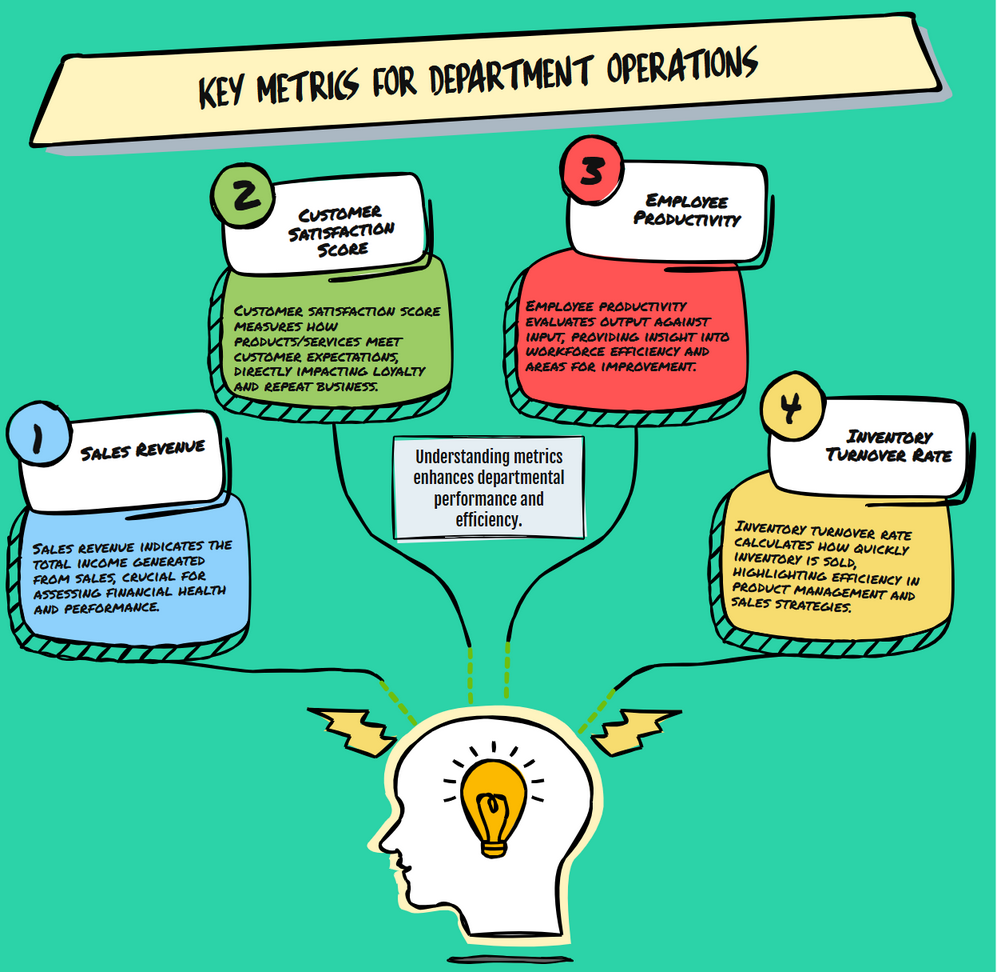
Operational metrics are quantitative measurements that assess the performance, efficiency, and effectiveness of a business’s daily operations. They provide a snapshot of how a company is performing in key areas, such as productivity, quality, and customer satisfaction, allowing leaders to make data-driven decisions and drive continuous improvement.
Table of Contents
What Are Operational Metrics?
Operational metrics are quantifiable values used to monitor your company’s daily functions and processes. These figures reveal your company’s effectiveness in various areas, including customer service and production. Consider them your business dashboard—they highlight strengths, weaknesses, and where to direct your attention.
Unlike financial metrics, which measure revenue and expenses, business performance indicators evaluate operational activities. These measure response speed to customer emails, units produced per hour, or website outage frequency.
Why Operational Metrics Matter
Understanding your operational efficiency metrics helps guide your business in the right direction. Without them, you risk making decisions without clear information. Here’s why these metrics matter:
- Real-Time Visibility: These metrics provide a clear picture of what’s happening in your business right now. Instead of waiting for monthly reports, you can identify problems as they occur and address them promptly.
- Better Decision Making: With concrete data from process improvement metrics, you can allocate time and budget effectively. No more relying solely on intuition.
- Employee Accountability: Defined metrics clarify expectations for each role, ensuring a clear understanding of responsibilities. When employees know how they are assessed, they are more likely to excel.
- Customer Satisfaction: Many operational metrics have a direct impact on your customers. Tracking items like response times and quality ratings enables you to improve the experience you deliver.
Types of Operational Metrics

Vanity Metrics vs. Actionable Metrics
Many commonly tracked operational metrics are actually “vanity metrics” that look impressive but don’t drive decision-making. Page views, total users, or gross revenue often fall into this category. Actionable metrics, such as conversion rates by traffic source or customer acquisition costs by channel, directly inform strategic decisions and resource allocation.
Quality Metrics
Quality metrics are quantitative measures used to assess the performance, reliability, and effectiveness of a product, process, or system. These metrics provide objective data to evaluate whether standards are met, identify areas for improvement, and ensure consistency in outcomes. Common examples include defect rates, customer satisfaction scores, cycle time, and compliance rates. By tracking quality metrics, organizations can make data-driven decisions, enhance efficiency, and align with strategic goals. Effective use of quality metrics fosters continuous improvement, reduces waste, and ensures high standards in deliverables, ultimately boosting customer trust and operational success.
Speed Metrics
Speed metrics help measure how quickly and efficiently a process or system works. They track how long it takes to complete tasks, deliver services, or achieve goals, providing a clear picture of performance. Common examples are response time, throughput, cycle time, and transaction processing speed. By monitoring these metrics, organizations can identify slowdowns, optimize workflows, and enhance user satisfaction. Using speed metrics effectively helps businesses run smoothly, meet deadlines, and stay ahead in fast-paced industries while maximizing the use of their resources.
Volume Metrics
Volume metrics are quantitative measures used to evaluate the scale, capacity, or output of a process, system, or operation within a specific timeframe. These metrics focus on the quantity of work completed, items produced, or transactions processed, providing insight into operational efficiency and resource utilization. Examples include production volume, transaction counts, data transfer rates, and customer interaction volumes. By tracking volume metrics, organizations can assess performance trends, identify capacity constraints, and optimize resource allocation to improve efficiency. Effective use of volume metrics supports strategic decision-making, enhances scalability, and ensures systems can handle demand while maintaining quality and efficiency.
Cost Metrics
Cost metrics are quantitative measures that assess the financial efficiency and expenditures of a process, project, or system. These metrics track expenses, resource allocation, and cost-effectiveness to ensure alignment with budgetary objectives. Common examples include cost per unit, operational expenses, return on investment (ROI), and cost variance. Monitoring cost metrics allows organizations to identify overspending, optimize resource utilization, and increase profitability. The systematic application of cost metrics facilitates data-driven decision-making, supports adherence to budgets, and improves financial performance while upholding quality and operational efficiency.
Key Performance Indicators vs Operational Metrics

Operational Metrics Update in Real-Time, KPIs Require Strategic Context
Most operational metrics can be automated and updated continuously (such as server response times, daily transactions, and inventory levels), but meaningful KPIs often require additional context, analysis, and sometimes manual interpretation before they become actionable. A KPI indicating declining customer satisfaction may require qualitative research, competitive analysis, or market condition assessment to be truly useful for informed decision-making.
Many people get confused about the difference between KPIs (Key Performance Indicators) and operational metrics. Here’s how they differ:
Key Performance Indicators are the most important metrics that directly relate to your business goals. They’re usually strategic and high-level. Examples include:
- Revenue growth
- Customer retention rate
- Market share
- Net promoter score
Operational metrics, on the other hand, are more tactical and detailed. They help you understand the day-to-day activities that support your KPIs. For example:
- If customer retention is your KPI, your operational metrics might include support ticket resolution time, product quality scores, and onboarding completion rates.
Think of KPIs as the destination and operational metrics as the turn-by-turn directions to get there.
Essential Operational Metrics for Different Departments

Sales Department
Sales performance metrics help track how well your team is converting leads into customers:
- Conversion rate: Percentage of leads that become customers.
- Sales cycle length: Average time from first contact to closed deal.
- Activity metrics: Number of calls made, emails sent, meetings scheduled.
- Pipeline velocity: How quickly deals move through your sales process.
- Win rate: Percentage of deals that close successfully.
Customer Service
Customer service metrics focus on helping people and solving problems:
- First response time: How quickly you reply to customer inquiries.
- Resolution time: Average time to solve customer problems.
- Customer satisfaction score: How happy customers are with your service.
- Ticket volume: Number of support requests received.
- Agent utilization: How efficiently your support team works.
Manufacturing and Operations
Production efficiency metrics track how well you make and deliver products:
- Throughput: Number of units produced in a given time.
- Cycle time: Time to complete one production cycle.
- Equipment downtime: How often machines break down or need maintenance.
- Yield rate: Percentage of products that meet quality standards.
- Inventory turnover: How quickly you use up and replace inventory.
Marketing
Marketing effectiveness metrics measure how well you attract and engage customers:
- Website traffic: Number of visitors to your site.
- Lead generation: Number of potential customers identified.
- Email open rates: Percentage of people who read your emails.
- Social media engagement: Likes, shares, comments on your posts.
- Cost per lead: How much you spend to get one potential customer.
Human Resources
Workforce productivity metrics help manage your team:
- Employee turnover rate: How often people leave your company
- Time to hire: How long it takes to fill open positions
- Training completion rates: Percentage of employees who finish required training
- Absenteeism rate: How often employees miss work
- Performance review scores: How well employees are doing their jobs
How to Choose the Right Metrics
Choosing the right metrics involves aligning measurements with specific goals, ensuring they are relevant, actionable, and easy to understand. Start by defining clear objectives for the process, project, or system, such as improving quality, speed, volume, or cost efficiency. Select metrics that directly reflect progress toward these goals, like defect rates for quality, cycle time for speed, transaction counts for volume, or cost per unit for financial performance. Ensure metrics are measurable, based on reliable data, and provide insights for decision-making. Avoid vanity metrics that don’t drive meaningful action, and periodically review chosen metrics to confirm they remain aligned with evolving priorities and deliver actionable results.
Tools for Tracking Operational Metrics
You don’t need expensive software to start tracking business performance indicators. Here are some options:
- Excel or Google Sheets: Great for basic tracking and calculations
- Google Analytics: Perfect for website and marketing metrics
- Email marketing platforms: Most include built-in metrics tracking
- CRM systems: Help track sales and customer service metrics
Common Mistakes When Using Metrics
- Tracking Too Many Things: Measuring too many metrics can cause confusion. Focus on key indicators that align with your goals.
- Not Acting on the Data: Metrics matter only when used for improvement. Set clear review and action processes.
- Setting Unrealistic Goals: Unrealistic goals can hurt progress. Set objectives that are achievable yet challenging.
- Ignoring Context: Metrics alone miss context. For example, onboarding can lower productivity.
- Not Communicating Results: Make results clear so everyone stays engaged and informed.
- Focusing Only on Lagging Indicators: Lagging metrics reflect the past; leading metrics predict the future. Use both.
Best Practices for Implementation
Implementing metrics effectively requires a strategic approach to ensure they drive meaningful improvements and align with organizational goals. Begin by clearly defining objectives and identifying key performance indicators (KPIs) that are specific, measurable, achievable, relevant, and time-bound (SMART). Engage stakeholders to ensure buy-in and alignment across teams. Collect accurate and consistent data using reliable tools and systems, and establish a baseline for comparison and future reference. Automate data collection where possible to reduce errors and save time.
Regularly analyze and visualize metrics through dashboards or charts to gain clear insights, and communicate the findings transparently to relevant teams. Continuously review and refine metrics to adapt to changing priorities, ensuring they remain actionable and focused on driving performance improvements without overwhelming resources or creating unnecessary complexity.
Conclusion
Operational metrics guide business success by revealing what works, highlighting emerging issues, and enabling more informed decisions based on real data.
Focus on the key metrics that serve your business objectives and act on their findings. Metrics such as customer service times and manufacturing efficiency help drive organizational strength and effectiveness.
Remember, the best metrics are the ones you actually use. Start with a few important ones, get comfortable with the process, and gradually expand your measurement program. By focusing on practical and actionable metrics, you’ll make data-driven decisions that support your company’s growth.
Download our operational metrics guide
